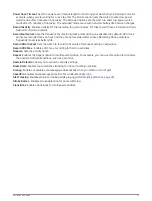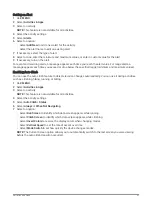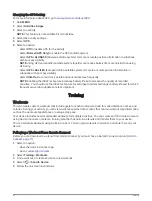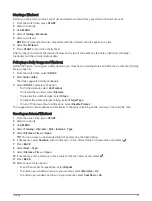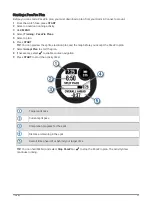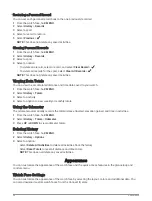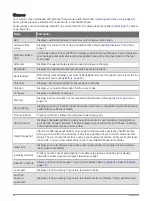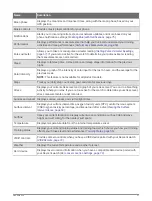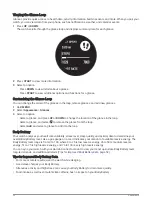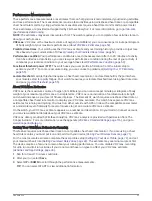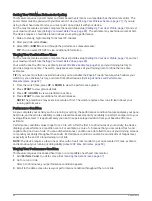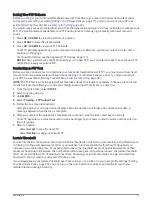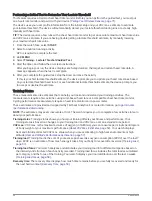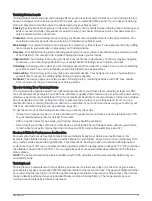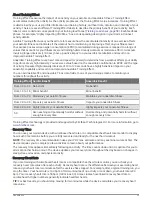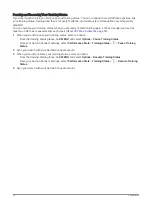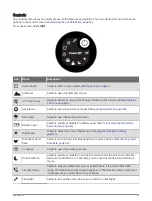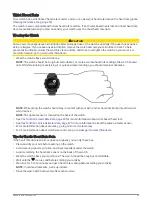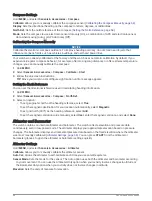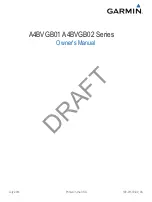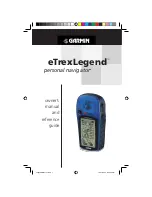
Performance Measurements
These performance measurements are estimates that can help you track and understand your training activities
and race performances. The measurements require a few activities using wrist-based heart rate or a compatible
chest heart rate monitor. Cycling performance measurements require a heart rate monitor and a power meter.
These estimates are provided and supported by Firstbeat Analytics
™
. For more information, go to
NOTE: The estimates may seem inaccurate at first. The watch requires you to complete a few activities to learn
about your performance.
VO2 max.: VO2 max. is the maximum volume of oxygen (in milliliters) you can consume per minute per kilogram
of body weight at your maximum performance (
About VO2 Max. Estimates, page 53
).
Predicted race times: Your watch uses the VO2 max. estimate and your training history to provide a target race
time based on your current state of fitness (
Viewing Your Predicted Race Times, page 54
).
Performance condition: Your performance condition is a real-time assessment after 6 to 20 minutes of activity.
It can be added as a data field so you can view your performance condition during the rest of your activity. It
compares your real-time condition to your average fitness level (
Performance Condition, page 54
).
Functional threshold power (FTP): The watch uses your user profile information from the initial setup to
estimate your FTP. For a more accurate rating, you can conduct a guided test (
).
Lactate threshold: Lactate threshold requires a chest heart rate monitor. Lactate threshold is the point where
your muscles start to rapidly fatigue. Your watch measures your lactate threshold level using heart rate data
and pace (
).
About VO2 Max. Estimates
VO2 max. is the maximum volume of oxygen (in milliliters) you can consume per minute per kilogram of body
weight at your maximum performance. In simple terms, VO2 max. is an indication of cardiovascular strength
and should increase as your level of fitness improves. The Descent G1 watch requires wrist-based heart rate or
a compatible chest heart rate monitor to display your VO2 max. estimate. The watch has separate VO2 max.
estimates for running and cycling. You must run either outside with GPS or ride with a compatible power meter
at a moderate level of intensity for several minutes to get an accurate VO2 max. estimate.
On the watch, your VO2 max. estimate appears as a number and description. On your Garmin Connect account,
you can view additional details about your VO2 max. estimate.
VO2 max. data is provided by Firstbeat Analytics. VO2 max. analysis is provided with permission from The
Cooper Institute
®
. For more information, see the appendix (
VO2 Max. Standard Ratings, page 116
), and go to
.
Getting Your VO2 Max. Estimate for Running
This feature requires wrist-based heart rate or a compatible chest heart rate monitor. If you are using a chest
heart rate monitor, you must put it on and pair it with your device (
Pairing Your Wireless Sensors, page 71
).
For the most accurate estimate, complete the user profile setup (
Setting Up Your User Profile, page 79
), and set
your maximum heart rate (
Setting Your Heart Rate Zones, page 80
). The estimate may seem inaccurate at first.
The device requires a few runs to learn about your running performance. You can disable VO2 max. recording
for ultra run and trail run activities if you do not want those run types to affect your VO2 max. estimate
(
Activities and App Settings, page 38
).
1 Run for at least 10 minutes outdoors.
2 After your run, select Save.
3 Select UP or DOWN to scroll through the performance measurements.
TIP: You can select START to view additional information.
Appearance
53

